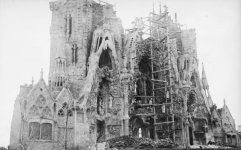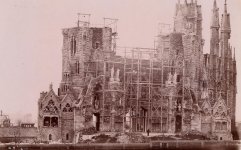Jumping ahead I will say this. It appears (to me, at least) that de Paula del Villar, and the great Gaudi were simply trying to finish (in 1882) the construction project initiated by someone else. Today, in 2019 the Basílica is still under construction.
The Basílica i Temple Expiatori de la Sagrada Família is a large unfinished Roman Catholic church in Barcelona, designed by Catalan architect Antoni Gaudí (originally Francisco de Paula del Villar was commissioned for the job, but he quit). Gaudí's work on the building is part of a UNESCO World Heritage Site, and in November 2010 Pope Benedict XVI consecrated and proclaimed it a minor basilica, as distinct from a cathedral, which must be the seat of a bishop.
Francisco de Paula del Villar

1828-1901
We are not really interested in this guy, for he barely participated in the entire Sagrada Família saga. Villar studied architecture in Madrid at the Academia de Bellas Artes de San Fernando, and qualified in 1852.1828-1901
- In 1854 he designed a series of emergency hospitals for victims of the cholera epidemic.
- He became president of the Association of Architects and director of the Higher School of Architecture.
- He held the post of diocesan architect from 1874 to 1892, and was succeeded in it by his son Francesc de Paula del Villar i Carmona.
- He restored the church of Santa Maria del Pi, the Basílica de Santa Maria de Vilafranca and the Casa de Misericòrdia;
- he also designed many parish churches and the apse of the basilica of the Monastery of Montserrat.
- Antoni Gaudí worked under him in a junior capacity.
- KD: this de Paula del Villar appears to bemore important than what we are allowed to know, but he is a non-factor in our story. At least officially he is.
Antoni Gaudí
1852-1926
- Gaudí's work was influenced by his passions in life: architecture, nature, and religion. He considered every detail of his creations and integrated into his architecture such crafts as ceramics, stained glass, wrought ironwork forging and carpentry. He also introduced new techniques in the treatment of materials, such as trencadís which used waste ceramic pieces.
- Under the influence of neo-Gothic art and Oriental techniques, Gaudí became part of the Modernista movement which was reaching its peak in the late 19th and early 20th centuries. His work transcended mainstream Modernisme, culminating in an organic style inspired by natural forms. Gaudí rarely drew detailed plans of his works, instead preferring to create them as three-dimensional scale models and moulding the details as he conceived them.
- Gaudí's work enjoys global popularity and continuing admiration and study by architects. His masterpiece, the still-incomplete Sagrada Família, is the most-visited monument in Spain. Between 1984 and 2005, seven of his works were declared World Heritage Sites by UNESCO. Gaudí's Roman Catholic faith intensified during his life and religious images appear in many of his works. This earned him the nickname "God's Architect" and led to calls for his beatification.
- Most of his service was spent on sick leave, enabling him to continue his studies. His poor health kept him from having to fight in the Third Carlist War, which lasted from 1872 to 1876.
- During this time Gaudí studied architecture at the Llotja School and the Barcelona Higher School of Architecture, graduating in 1878.
- His grades were average and he occasionally failed courses.
- When handing him his degree, director of Barcelona Architecture School, said:
- "We have given this academic title either to a fool or a genius. Time will show."
- Gaudí, when receiving his degree, reportedly told his friend, the sculptor Llorenç Matamala:
- "Llorenç, they're saying I'm an architect now."
Gaudí: End of Life & Death
Gaudí left hardly any written documents, apart from technical reports of his works required by official authorities, some letters to friends (particularly to Joan Maragall) and a few journal articles. Some quotes collected by his assistants and disciples have been preserved. The only written document Gaudí left is known as the Manuscrito de Reus (Reus Manuscript) (1873–1878), a kind of student diary in which he collected diverse impressions of architecture and decorating, putting forward his ideas on the subject. Included are an analysis of the Christian church and of his ancestral home, as well as a text about ornamentation and comments on the design of a desk.On 7 June 1926, Gaudí was taking his daily walk to the Sant Felip Neri church for his habitual prayer and confession. While walking between Girona and Bailén streets, he was struck by a passing number 30 tram and lost consciousness. Assumed to be a beggar because of his lack of identity documents and shabby clothing, the unconscious Gaudí did not receive immediate aid. Eventually some passers-by transported him in a taxi to the Santa Creu Hospital, where he received rudimentary care.
- By the time that the chaplain of the Sagrada Família, Mosén Gil Parés, recognised him on the following day, Gaudí's condition had deteriorated too severely to benefit from additional treatment. Gaudí died on 10 June 1926 at the age of 73 and was buried two days later. A large crowd gathered to bid farewell to him in the chapel of Our Lady of Mount Carmel in the crypt of the Sagrada Família.
- Antonius Gaudí Cornet. Reusensis. Annos natus LXXIV, vitae exemplaris vir, eximiusque artifex, mirabilis operis hujus, templi auctor, pie obiit Barcinone die X Junii MCMXXVI, hinc cineres tanti hominis, resurrectionem mortuorum expectant. R.I.P.
- (Antoni Gaudí Cornet. From Reus. At the age of 74, a man of exemplary life, and an extraordinary craftsman, the author of this marvelous work, the church, died piously in Barcelona on the tenth day of June 1926; henceforward the ashes of so great a man await the resurrection of the dead. May he rest in peace.)
Basílica i Temple Expiatori
de la Sagrada Família
In 1882, construction of Sagrada Família started under architect Francisco de Paula del Villar. In 1883, when Villar resigned, Gaudí took over as chief architect, transforming the project with his architectural and engineering style, combining Gothic and curvilinear Art Nouveau forms. Gaudí devoted the remainder of his life to the project, and he is buried in the crypt. At the time of his death at age 73 in 1926, when he was run down by a tram, less than a quarter of the project was complete.de la Sagrada Família
- 0% complete - 1882
- 25% complete - 1926
- 70% complete - 2015
- 100% projected - 2026
La Sagrada Familia under construction, 1887.
Source
1889
Work on the Sagrada Familia in 1889
The upper part of the crypt and the beginning of the apse
Source
1892
Source
1893
L'apse in 1893
Source +1
1896
Portrait of soldiers in front of the Sagrada Familia (1896), photograph by Pau Audouard
Source
1896
Construction of the Nativity Façade 1896
Source
1898
Works of the Sagrada Familia (1908), anonymous photo published in La Ilustració Catalana, Barcelona, January 3, 1909.
Sources and Links:
Sagrada Família - Wikipedia
Sagrada Familia - Chronology
One-minute 3D animation shows final phases of Gaudí's Sagrada Família
Antoni Gaudí - Wikipedia
Francisco de Paula del Villar y Lozano - Wikipedia
History of the Temple - Sagrada Família - Sagrada Familia
2019, the year the Sagrada Família skyline starts to change - Blog Sagrada Família
Antoni Gaudí, Sagrada Família – Smarthistory
Curiosities about Sagrada Família in Barcelona - What to do in Barcelona
List of Gaudí buildings - Wikipedia
Just figured I would add this cathedral to the list of the ones we already have. This is clearly one amazing piece of architecture. 144 years to complete the construction is a long time, especially considering today's technological capabilities.
2026 looks
I guess, one of the problems I have with this structure, is its progression from 1882 to 1889, and from 1889 to 1893. It appears that nothing major was constructed from 1882 to 1889. Than all over sudden within the next four years the building grew exponentially. After 1893 the construction slowed, and continued at a snail pace through present times.
The 1896 photograph (above) has that small barn which kind of does not belong. It appears way to permanent of a structure for our elaborate Goudi to include it in its project. As a matter of fact, when you consider Gaudi's vision, this barn becomes an atrocity.
Then we have the mystery of Mr. Gaudi himself. His architecture is out of this world, and requires further investigation. Also, what's up with the "unfinished" structures of his?
KD: Officially, everything appears to be making sense, including the photographic sequence. Did we get the entire story though?



